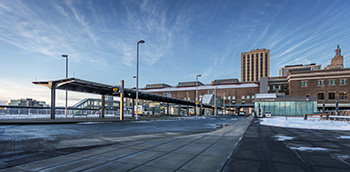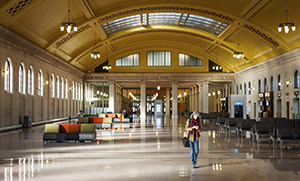St. Paul’s Union Depot Earns LEED Gold
 ST. PAUL, Minn. — Through detailed teamwork and a focus on sustainability, the $243 million renovation of the historic Union Depot has achieved LEED Gold certification.
ST. PAUL, Minn. — Through detailed teamwork and a focus on sustainability, the $243 million renovation of the historic Union Depot has achieved LEED Gold certification.
The renovation project was designed by HGA Architects, with offices in Minneapolis, and constructed by Minneapolis-headquartered Mortensen Construction. The design preserves the historic significance of the 1926 building, which was added to the National Register of Historic Places in 1974, while also creating a new multimodal transit hub for passenger rail, light rail, bus, bicycle and pedestrian commuters.
Though the fast-paced, design-build project came with many challenges, the revitalization was able to exceed its initial sustainable goals through strong partnerships and a shared vision.
“Pursuing LEED is difficult in a restoration,” said Michael Bjornberg, project architect with HGA. “There are so many points you can’t go after because you already have a building.”
The project team had initially set green building requirements for LEED Silver certification. But after reviewing LEED points and partnering with District Energy to provide renewable heating and cooling services, the project team set their sights on gold.
“It came to our understanding that District Energy could assist us in acquiring certain credits to get us to a point where we could get LEED,” said Gerhard Guth, architectural specifier with HGA. “Without District Energy, this building would have had a very difficult time even meeting LEED.”
With inclusion of district heating and cooling, the project team put forth additional cost, time and concerted effort into building the green transit hub. The project team also appealed credits in order to meet its goals.
“From Silver to Gold, it really came down to looking at all our credits and looking harder at the credits we had vetted through,” Bjornberg said.
 Some green building features at Union Depot include a bicycle station, electric vehicle charging stations, fuel-efficient vehicle parking, daylighting, stormwater control and water-efficient landscaping.
Some green building features at Union Depot include a bicycle station, electric vehicle charging stations, fuel-efficient vehicle parking, daylighting, stormwater control and water-efficient landscaping.
Because the building is owned by the Ramsey County Regional Railroad Authority and the project has such high historical significance, the project team had to work with several different agencies in order to meet the needs of all involved. The project team met with the local transportation agency in order to ensure that all stakeholders were able to share their specific insight.
“We wanted to make sure the front end met their very specific criteria. Because we’re dealing with two different worlds, there are certain aspects that they are familiar with and we are not and vice versa,” Guth said. “We wanted to have these conversations so we didn’t have any hiccups along the way.”
From the onset of the project, the greatest tool was teamwork, Bjornberg said. The entire project team had signed on to the historical and sustainable significance of the project from the beginning.
“In this case, it’s important to have team players that are very well aware of what the process means and how to get there,” Guth said.
